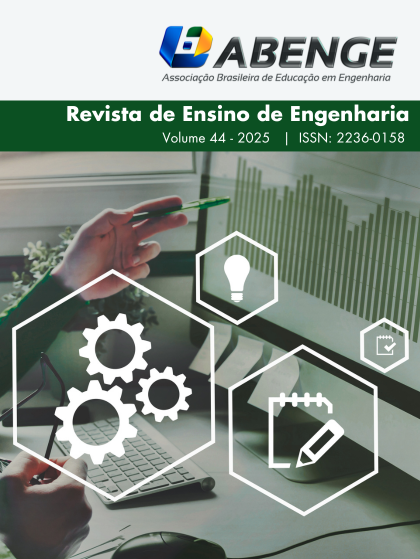Scale-Tech Learning: A Scaled Model for Innovative Training in Electrical Engineering Based on Deep Techs
Keywords:
Electrical Engineering, Scale-Tech Learning, KRLs, TRLs, PIAAbstract
This article addresses the historical challenges faced by Electrical Engineering education in reconciling theory and practice, highlighting the difficulty of transposing academic concepts to real work contexts. In response to this scenario, we propose the adoption of active methodologies – such as PBL, PjBL, Flipped Classroom, Hybrid Learning and Peer Instruction – widely recognized for promoting meaningful, collaborative learning based on the resolution of complex problems. The central innovation of the article is the introduction of the Scale-Tech Learning methodology, which combines the principles of disruptive technologies (Deep Techs) with the Scaling-Up process, adapted to the educational environment. This methodology structures learning in five interdependent phases: Fixation, Reasoning, Abstraction, Memorization and Explanation (FRAME), associated with a progressive assessment system called Knowledge Readiness Levels (KRLs) – inspired by NASA's Technology Readiness Levels (TRLs). The Individual Learning Plan (PIA) is presented as a central methodological instrument, allowing student progress to be accurately monitored, integrating personalized goals, learning evidence, and technological resources such as MATLAB and Arduino. The methodology was applied in a pilot study with 78 undergraduate students, revealing: (i) a 36% increase in the transition from KRL 3 to KRL 4; (ii) 78% of students reaching KRL 4; and (iii) a 40% reduction in prototyping time. The article defends the scalability of the Scale-Tech Learning methodology for multiple levels of education (technical, undergraduate, and postgraduate), highlighting its potential to drive technological innovation and promote the articulation between teaching, research, and extension. The proposal is aligned with the guidelines of CNE/CES Resolution No. 1/2022 and with the Legal Framework for Innovation, offering an empirically validated alternative for curricular transformation in Engineering.
References
BIGGS, J.; TANG, C. Teaching for quality learning at university: what the student does. Open University Press, 2011.
BRASIL. Ministério da Educação. Conselho Nacional de Educação. Câmara de Educação Superior. Resolução CNE/CES nº 1, de 6 de abril de 2022. Institui as Diretrizes Curriculares Nacionais do Curso de Graduação em Engenharia e dá outras providências. Diário Oficial da União: seção 1, Brasília, DF, n. 66, p. 81-83, 7 abr. 2022.
BRASIL. Ministério da Educação. Base Nacional Comum Curricular. Brasília: MEC, 2017. Disponível em: https://basenacionalcomum.mec.gov.br/. Acesso em: 14 jul. 2023.
CANTO FILHO, A. B. do. Avaliação formativa na Engenharia Elétrica. Porto Alegre: UFRGS, 2023.
ELMÔR, G. F. et al. Uma nova sala de aula é possível: aprendizagem ativa na educação em engenharia. Rio de Janeiro: LTC, 2019.
FELDER, R. M.; SILVERMAN, L. K. Learning and teaching styles in engineering education. Engineering Education, v. 78, n. 7, p. 674-681, 1988.
GRAHAM, C. R. Blended learning systems: definition, current trends, and future directions. In: BONK, C. J.; GRAHAM, C. R. (ed.). The handbook of blended learning: global perspectives, local designs. San Francisco: Pfeiffer, 2006.
LIGHT, G.; COX, R. Learning and teaching in higher education: the reflective professional. London: Paul Chapman, 2001.
LIMA, I. G.; SAUER, L. Z. Active learning based on interaction and cooperation motivated by playfull tone. Proceedings… Active Learning in Engineering Education, 13. San Sebastian, 2015.
MANKINS, J. C. Technology readiness levels: a white paper. NASA, 1995.
NOVAK, G. M. Just-in-time teaching. New Directions for Teaching and Learning, n. 128, 2011.
PAPERT, S. Mindstorms: children, computers, and powerful ideas. New York: Basic Books, 1980.
RIBEIRO, L. R. C. Aprendizagem baseada em problemas (PBL) na educação em engenharia. Revista de Ensino de Engenharia, v. 27, n. 2, 2008.
TRUMBULL, E.; LASH, A. Understanding formative assessment: insights from learning theory and measurement theory. WestEd, 2013. Disponível em: http://www.wested.org/wp-content/files_mf/1370912451resource13071.pdf. Acesso em: 12 jan. 2025.
SUKACKE, V. et al. Towards active evidence-based learning in engineering education: a systematic literature review of PBL, PjBL, and CBL. Sustainability, v. 14, n. 13955, 2022.
WILENSKY, U.; RESNICK, M. Thinking in levels: a dynamic systems approach to learning about complexity. Cambridge: MIT Press, 1999a.
WILENSKY, U.; RESNICK, M. Thinking in levels: a dynamic systems approach to making sense of the world. Journal of Science Education and Technology, v. 8, p. 3–19, 1999b.
WINNE, P. H.; PERRY, N. E. Measuring self-regulated learning. In: ZIMMERMAN, B. J.; SCHUNK, D. H. (ed.). Handbook of self-regulation. Elsevier, 2000.
ZHANG, K. E. et al. Learning analytics in formative assessment: a systematic literature review. Journal of Measurement and Evaluation in Education and Psychology, v. 14, 2023.


